Kids & Families/ Have fun with our animal art trail at QAG & GOMA!

Sandra Taylor, New South Wales Australia b.1942 / Sculpture: Bella casa 1978-79 / Stoneware, slab built and modelled with overglaze colours and lustres with aluminium, shells, coral and framed prints / 32 x 64 x 70cm (complete, approx.); house: 31 x 40.9 x 30.9cm; pool: 26 x 42 x 34cm; four palms: 30 x 22 x 14cm (approx.); three palms: 32 x 41 x 9.5cm (approx.) / Purchased 1980 with the assistance of the Crafts Board of the Australia Council / Collection: Queensland Art Gallery | Gallery of Modern Art / © QAGOMA / View full image
Ignite a child's natural curiosity when you visit. Discover a wonderful menagerie of animals, some easy to spot; others waiting to be found. Did you know there's a shark living in the art gallery? Find our playful pigs, go bird watching, or keep an eye out for a pack of polar bears!
From the earliest paintings to today's contemporary works, animals have featured in art. Go on a self-guided animal art trail with us at the Queensland Art Gallery (QAG) and Gallery of Modern Art (GOMA).
Both our buildings are nestled beside the Brisbane River and are just a short stroll from each other, we're also close to South Bank Parklands to extend your day even further.
ANOTHER SELF-GUIDED ANIMAL ART TRAIL: Great and Small: Kindred Creatures in Indigenous Australian Art
Watch out for the shark!
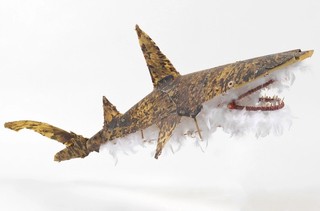
Ricardo Idagi, Meriam Mir people, Australia b.1957 / Beizam tirig 2009 / Turtle shell flake, feathers, saimi saimi seeds and string / 86.5 x 62 x 126cm / Purchased 2009 with funds from the Bequest of Grace Davies and Nell Davies through the QAG Foundation / Collection: Queensland Art Gallery | Gallery of Modern Art / © Richardo Idagi / View full image
Start your self-guided animal art trail
In this selection of animals — from the two-legged, the four-legged, to the many legged kind — you'll find QAGOMA has them all in painting, sculpture, jewellery, and decorative objects. How many more can you find?
Queensland Art Gallery

Queensland Art Gallery Animal Trail Map / View full image
Find two mice who love art
Roy and Matilda are two mice who love art galleries. When visiting one day, they set about making a cosy home. A man who worked in the Galley restoring and carving frames found they were living here and decided to make them a special monogrammed front door. See if the're home when you visit.
Location: Gallery 11. Australian Art Collection, Josephine Ulrick and Win Schubert Galleries, Queensland Art Gallery

Look for Roy and Matilda’s front door in the Australian Art Collection / View full image
Fifteen dancing brolgas... can you count them all?
Brolgas are known for their intricate dance and trumpeting sound. This painting shows people and birds united by music.
Nearby: Find the Australian Kelpie and the shark.
Location: Gallery 11. Australian Art Collection, Josephine Ulrick and Win Schubert Galleries, Queensland Art Gallery

Sydney Long, Australia 1871-1955 / Spirit of the Plains 1897 / Oil on canvas on wood / 62 x 131.4cm / Gift of William Howard-Smith in memory of his grandfather, Ormond Charles Smith 1940 / Collection: Queensland Art Gallery | Gallery of Modern Art / View full image
Find the restful Australian Kelpie

Hilda Rix Nicholas, Australia 1884-1961 / The fair musterer 1935 / Oil on canvas / 102.3 x 160.4cm / Purchased 1971 / Collection: Queensland Art Gallery | Gallery of Modern Art / © Hilda Rix Nicholas Estate / View full image
Locate our celestial shark

Ricardo Idagi, Meriam Mir people, Australia b.1957 / Beizam tirig 2009 / Turtle shell flake, feathers, saimi saimi seeds and string / 86.5 x 62 x 126cm / Purchased 2009 with funds from the Bequest of Grace Davies and Nell Davies through the QAG Foundation / Collection: Queensland Art Gallery | Gallery of Modern Art / © Richardo Idagi / View full image
Spot our white dove
Birds regularly appear in paintings. As a child this artist was a frequent visitor to Sydney’s Taronga Park Zoo and developed a lifelong love of animals and the natural world.
Location: Gallery 12. Australian Art Collection, Josephine Ulrick and Win Schubert Galleries, Queensland Art Gallery

Brett Whiteley, Australia 1939–1992 / White dove feeling the universe 1985–92 / Oil on plywood / 80.5 x 76.8cm / Gift of the Josephine Ulrick and Win Schubert Foundation for the Arts through the QAG Foundation 2012. Donated through the Australian Government’s Cultural Gifts Program / Collection: Queensland Art Gallery | Gallery of Modern Art / © Wendy Whiteley / View full image
Can you locate all the camel pieces?
This work is playful and witty, the segmented 'Jumble Animals' take inspiration from the back of Kellogg’s breakfast cereal boxes which were designed to be cut out and reassembled by children, like a jigsaw. In this version, it's a little harder as you have to piece it together in your mind.
Location: Gallery 13. Australian Art Collection, Josephine Ulrick and Win Schubert Galleries, Queensland Art Gallery

Robert Rooney, Australia 1937–2017 / Silly Symphony 7 (Camel Cuts) 1988 / Liquitex on canvas / 129.8 x 183.1cm / Gift of Clinton Tweedie as a tribute to his parents Heather and Arthur Tweedie through the QAGOMA Foundation 2024. Donated through the Australian Government's Cultural Gifts Program / Collection: Queensland Art Gallery | Gallery of Modern Art / © Robert Rooney Estate / View full image
Pick out the four goannas
This painting is from one of the traditional Indigenous Australian dreaming stories, and this work shows four goanna's moving towards a waterhole. The work has a strong sense of symmetry, one half is a mirror image of the other.
Location: Gallery 13. Australian Art Collection, Josephine Ulrick and Win Schubert Galleries, Queensland Art Gallery

Kaapa Mbitjana Tjampitjinpa, Anmatyerre/Arrernte people, Australia c.1925–89 / Goanna Story c.1973–74 / Synthetic polymer paint on board / 76 x 60.2cm / Purchased 1996 with funds from National Australia Bank Limited through the QAG Foundation / Collection: Queensland Art Gallery | Gallery of Modern Art / © Kaapa Mbitjana Tjampitjinpa Estate/Licensed by Aboriginal Artists Agency / View full image
Go bird watching
Head back down the Gallery on the way to the International Art Collection and find all the native animals carved into the sideboard, then drop by our Red-tailed Black Cockatoos.
Location: Gallery 10. Australian Art Collection, Josephine Ulrick and Win Schubert Galleries, Queensland Art Gallery
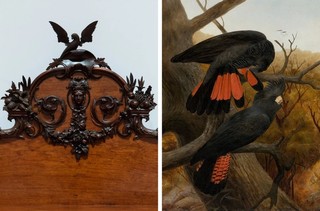
(l-r) Joshua Ebenston, Australia c.1835-1877; Matthew Fern, Australia 1831-1898, ‘Glengallan’ sideboard 1868, Cedar, carved, 198 x 242 x 70cm, Purchased 1995 with funds from the Australian Decorative & Fine Arts Society (Brisbane) Inc. through and with the assistance of the QAG Foundation and the QAG Foundation Grant. Celebrating the Queensland Art Gallery’s Centenary 1895-1995 / Anthony Alder, Australia 1838-1915, (Red-tailed Black Cockatoos) c.1895, Oil on canvas, 90.7 x 70cm, Purchased 2014. QAGOMA Foundation / Collection: Queensland Art Gallery | Gallery of Modern Art / View full image
Search for all the birds, we count 10
This screen of birds depicts change by including all four seasons within a singular landscape — from a snowy winter scene to the blooms of spring. How many birds can you find?
Nearby: Find a little green caterpiller
Location: Gallery 7. International Art Collection, Philip Bacon Galleries, Queensland Art Gallery
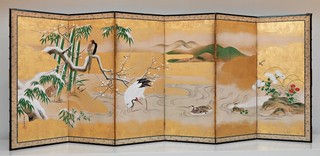
KanŌ Yasunobu, Japan 1613–85 / Pair of six-fold screens: Birds and flowers of the four seasons (detail) 17th century (Edo period) / Ink, gold and colours on paper on six-fold wooden framed screens / 131.2 x 245.7cm (each) / Purchased 2008 with funds from the Henry and Amanda Bartlett Trust through the QAG Foundation / Collection: Queensland Art Gallery | Gallery of Modern Art / View full image
Track down the green caterpillar
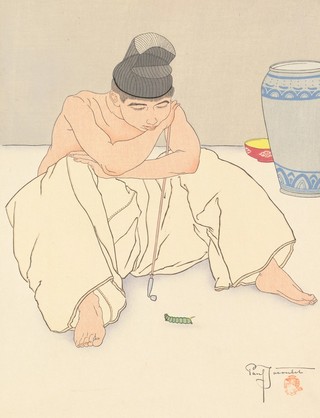
Paul Jacoulet, Japan 1896–1960 / Kentaro Maeda, Japan c.1891–c.1987 / La chenille verte. Coree (The green caterpillar. Korea) 1936 / Colour woodblock print on PJ watermarked paper / 43 x 33cm / Purchased 2023 with funds from the Airey Family through the QAGOMA Foundation / Collection: Queensland Art Gallery | Gallery of Modern Art / © Paul Jacoulet/ADAGP/Copyright Agency / View full image
Watch out for the flying dragonfly
The shapes and rhythms of nature inspired the style Art Nouveau. Find our collection of glass vases featuring delicately frosted animal and insects; and jewellery that take the form of a dragonfly brooch, and a comb featuring a ladybird sitting on a leaf.
Location: Gallery 7. International Art Collection, Philip Bacon Galleries, Queensland Art Gallery.

Unknown, possibly France / Libellule brooch early 20th century / Horn / 11.5cm (length) / Purchased 2021 with funds from the Henry and Amanda Bartlett Trust through the QAGOMA Foundation / Collection: Queensland Art Gallery | Gallery of Modern Art / View full image
Find the lucky ladybird beetle

Lucien Gaillard, France 1861–1942 / Comb (decorated with chestnut or maple leaf and ladybird) c.1900 / Horn and gold enamel / 12.5 x 7cm / Purchased 2021 with funds from the Henry and Amanda Bartlett Trust through the QAGOMA Foundation / Collection: Queensland Art Gallery | Gallery of Modern Art / View full image
Discover four pigs relaxing at home
This is definitely one of the cutest little homes you will see, substituting animals for people, with one relaxing on a couch, the others playing ball in the backyard swimming pool. Look closely at all the details from the heart shaped cushions to the white swan, green frog, and garden gnome.
Nearby: Check out the housebound tortoise who appears to carry the weight of the world on his back; the sleeping baby being cared for by a tree full of animals; and the squad of ten pink roaming polar bears.
Location: Pelican Lounge. Queensland Art Gallery
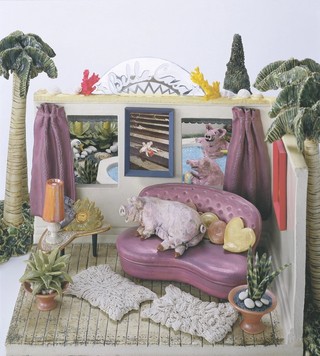
Sandra Taylor, New South Wales Australia b.1942 / Sculpture: Bella casa 1978-79 / Stoneware, slab built and modelled with overglaze colours and lustres with aluminium, shells, coral and framed prints / 32 x 64 x 70cm (complete, approx.); house: 31 x 40.9 x 30.9cm; pool: 26 x 42 x 34cm; four palms: 30 x 22 x 14cm (approx.); three palms: 32 x 41 x 9.5cm (approx.) / Purchased 1980 with the assistance of the Crafts Board of the Australia Council / Collection: Queensland Art Gallery | Gallery of Modern Art / © QAGOMA / View full image

Sandra Taylor, New South Wales Australia b.1942 / Sculpture: Bella casa 1978-79 / Stoneware, slab built and modelled with overglaze colours and lustres with aluminium, shells, coral and framed prints / 32 x 64 x 70cm (complete, approx.); house: 31 x 40.9 x 30.9cm; pool: 26 x 42 x 34cm; four palms: 30 x 22 x 14cm (approx.); three palms: 32 x 41 x 9.5cm (approx.) / Purchased 1980 with the assistance of the Crafts Board of the Australia Council / Collection: Queensland Art Gallery | Gallery of Modern Art / © QAGOMA / View full image
Find our housebound tortoise
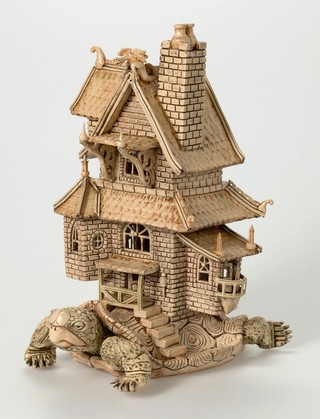
Midge Johansen, Australia b.1950 / Sculpture: Housebound 1982 / Stoneware, modelled and carved in the form of a tortoise with an elaborate house on its back / 36.1 x 24.5 x 29cm / Purchased 1982 / Collection: Queensland Art Gallery | Gallery of Modern Art / © QAGOMA / View full image
How many animals can you see in the tree?
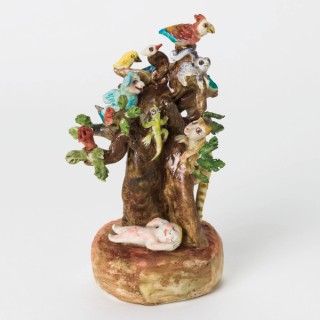
Elizabeth Olah, Australia b.1944 / Ornament: Sleeping baby 1981 / Porcelain, modelled and glazed and painted with polychrome overglaze colours / 13.6 x 8.5 x 6cm / Purchased 1981 with the assistance of the Crafts Board of the Australia Council / Collection: Queensland Art Gallery | Gallery of Modern Art / © QAGOMA / View full image
Discover our squad of pink polar bears
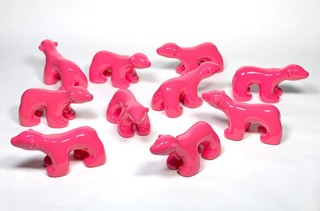
Scott Redford, Australia b.1962 / Michael Littler, Australia b.1964 / My beautiful pink polar bears 2005 / Ceramic / Ten bears: 26 x 25 x 50cm (each) / Gift of the Josephine Ulrick and Win Schubert Foundation for the Arts through the QAG Foundation 2009. Donated through the Australian Government's Cultural Gifts Program / Collection: Queensland Art Gallery | Gallery of Modern Art / © Scott Redford/Copyright Agency / View full image
Visit our local water dragons
The Gallery’s Watermall extends far beyond the Gallery’s interior, past the Dandelion fountains through to the reflection pond and Sculpture Courtyard. Visit the adjoining QAG Cafe and keep an eye out for our resident water dragons, Australia’s largest dragon lizard. Native to eastern Australia, they have a life span of around 20 years, though they can grow up to a metre in length, thankfully our contented residents aren’t that big. They are especially adapted to an aquatic life, and if you’re lucky you can watch them dive into the pond from the overhanging Tipuana tree and swim off using their powerful long tail.
Location: QAG Cafe. Watermall, Queensland Art Gallery

Water Dragons / View full image
Gallery of Modern Art
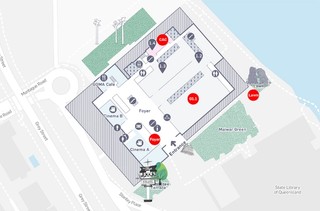
Gallery of Modern Art Animal Trail Map / View full image
Hermannsburg Pottery
In the sweeping plains and red-hued rolling ranges of the Central Desert in Northern Territory lies Ntaria (Hermannsburg). Here, a dedicated group of artists have pioneered pottery that has a distinctive style of hand-coiled clay vessels, often adorned with animals and matching sculptural lids. On display in 'old way, new way: Hermannsburg Pottery in the Collection' (until 26 October 2025).
Location: Entrance Foyer. Gallery of Modern Art
Find a couple of pink galahs

Hermannsburg Potters, Northern Territory, Australia est. 1990 / Judith Pungkarta Inkamala, Arrernte people, Australia b.1947 / Pink galahs at Imarlkna 2006 / Earthenware, hand-built terracotta clay with underglaze colours and applied decoration / 50 x 31.3 x 31cm (irreg.) (complete); pot: 34.7 x 31.3 x 31cm (irreg.); lid: 17 x 14 x 12cm / The James C. Sourris AM Collection. Gift of James C. Sourris AM through the QAGOMA Foundation 2018. Donated through the Australian Government's Cultural Gifts Program / Collection: Queensland Art Gallery | Gallery of Modern Art / © Judith Pungkarta Inkamala/Copyright Agency / View full image
Beware of the puffed-up frill-necked lizard
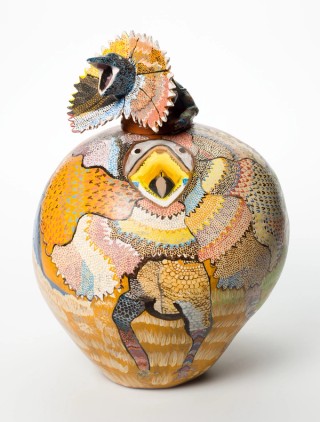
Hermannsburg Potters, Northern Territory, Australia est. 1990 / Rahel Ungwanaka, Arrernte/Luritja people, Australia b.1946 / Ankarta (Frill-necked lizard) 2005 / Earthenware, hand-built terracotta clay with underglaze colours and applied decoration / 39 x 26cm (diam.) (complete);pot: 28 x 26cm (diam.);lid: 12 x 17.5 x 13cm / Purchased 2006. QAG Foundation / Collection: Queensland Art Gallery | Gallery of Modern Art / © Rahel Ungwanaka / View full image
Wonderstruck
'Wonderstruck' (until 6 October 2025) explores the wonder that can be found in the ordinary and the extraordinary, the free exhibition invites visitors on a journey from spectacular large-scale artworks to captivating small treasures and immersive experiences.
Look for a deer obscured by glass and resin beads, the artist is fascinated by how we use our sense of sight to gather information from our environment. Can we always believe what we see, or can we be tricked? How many deer can you see? Not far away, find the New Zealand fur seal balancing a piano on its nose — that's right, a full size piano. If you keep looking, you'll discover many more animals in the exhibition, both large and small.
Location: Entrance level: Gallery 1.1 (The Fairfax Gallery). Gallery of Modern Art
How may deer can you see?
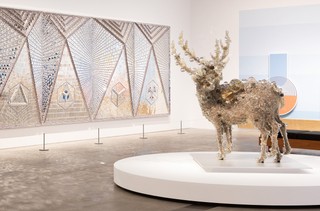
Kohei Nawa, Japan b.1975 / PixCell-Double Deer#4 2010 / Mixed media / 224 x 200 x 160cm / Purchased 2010 with funds from the Josephine Ulrick and Win Schubert Diversity Foundation through the QAG Foundation / Collection: Queensland Art Gallery | Gallery of Modern Art / © Kohei Nawa / Photograph: N Numek © QAGOMA / View full image
Find the seal and its gravity-defying balancing act
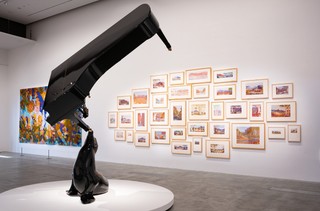
Michael ParekŌwhai, Ngati WhakarongoNgariki Rotoawe, New Zealand b.1968 / The Horn of Africa 2006 / Wood, fibreglass, steel, brass, automotive paint / 395 x 200 x 260cm / Purchased 2008 with funds from the Queensland Government's GOMA Acquisitions Fund in recognition of the contribution to the Gallery by Wayne Goss (Chair of Trustees 1999-2008) / Collection: Queensland Art Gallery | Gallery of Modern Art / © Michael Parekowhai / Photograph: N Numek © QAGOMA / View full image
Discover all the horses
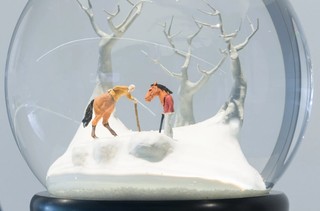
Walter Martin, United States b.1953; Paloma Muñoz, Spain b.1965 / Traveler 311 2016 / Snow globe / 19 x 15.2 x 15.2cm / Purchased 2023 with funds from Tim Fairfax AC through the QAGOMA Foundation / Collection: Queensland Art Gallery | Gallery of Modern Art / © Walter Martin and Paloma Muñoz / View full image

Nick Cave, United States b.1959 / HEARD 2012 / 15 wearable sculptures (six parts each) or as a performance, 15 wearable sculptures (six parts each), choreography, musical score and video / Purchased 2016 to mark the tenth anniversary of GOMA with funds from the Josephine Ulrick and Win Schubert Diversity Foundation through the QAGOMA Foundation / Collection: Queensland Art Gallery | Gallery of Modern Art / © Nick Cave / Photographs: James Prinz, courtesy of Nick Cave and Jack Shainman Gallery / View full image
Look for Kuril by the river
Down by the river in front of GOMA, can you find the kuril, a small native water rat, which forms part of this sculpture. In Aboriginal culture the kuril is an important animal who takes care of this area, the land where the Gallery stands. Kuril is a hero who, although small, has turned the world on its side. The world is represented by a giant elephant, can you see that it also looks like a book end?
Location: GOMA Bistro Lawn, Riverside. Gallery of Modern Art

Michael Parekowhai, Ngāti Whakarongo, New Zealand b.1968 / The World Turns 2011-12 / Bronze / 488 x 456 x 293cm (approx.) / Commissioned 2011 to mark the fifth anniversary of the opening of the Gallery of Modern Art in 2006 and twenty years of The Asia Pacific Triennial of Contemporary Art / This project has received financial assistance from the Queensland Government through art+place Queensland Public Art Fund, and from the QAG Foundation / Collection: Queensland Art Gallery | Gallery of Modern Art / © Michael Parekowhai / View full image

Michael Parekowhai, Ngāti Whakarongo, New Zealand b.1968 / The World Turns 2011-12 / Bronze / 488 x 456 x 293cm (approx.) / Commissioned 2011 to mark the fifth anniversary of the opening of the Gallery of Modern Art in 2006 and twenty years of The Asia Pacific Triennial of Contemporary Art / This project has received financial assistance from the Queensland Government through art+place Queensland Public Art Fund, and from the QAG Foundation / Collection: Queensland Art Gallery | Gallery of Modern Art / © Michael Parekowhai / View full image
Make a day of your visit
Visit the Children's Art Centre at GOMA to experience a range of free activities created in collaboration with local and international artists, children can explore their creativity through these making and multimedia interactives. Keep the fun going after your visit with our free online games or download the activities for all the family to join in.
Children's Art Centre (CAC)
Spend time at ‘Art Box for Kids: Mandy Quadrio’ to create a unique paper carrier to hold treasured objects. Watch the artist's behind-the-scenes video and visit until 26 October 2025.
Location: Entrance level. Gallery of Modern Art.

Mandy Quadrio invites children to create their own unique paper carrier / View full image
Watch | Mandy Quadrio invites you to create your own unique paper carrier
Games, drawing & making activities
Learn, play and explore with the Children's Art Centre's range of online games and activities.
We invite you to create your own musical composition. When Etson Caminha was a child, making music using recycled materials was a source of happiness and fun. Today, he creates sound-based artworks using natural elements, Timorese instruments and electronic equipment. In this interactive, experiment with music composition by selecting and layering pre-recorded videos.
Play 'My kitchen sounds'
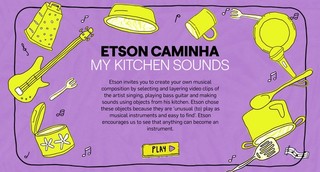
Etson Caminha: My Kitchen Sounds / View full image
Childrens books & gifts
While you’re here, why not pop-in to one of the three QAGOMA Stores packed with inspiring books, stylish accessories, designer homewares and cultural curios to take home. There’s something here for everyone, with a unique selection of books and gifts especially for children.
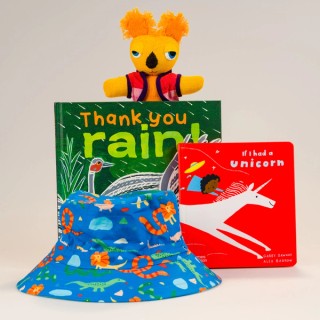
A unique selection of books and gifts especially for children / View full image
Eat & drink
If you work up an appetite on your visit, enjoy a bite to eat at one of our child friendly cafes. Just the treat for children: Chicken Tenders, Shoestring Fries, or Mini Fish Tacos, Mini Cheeseburger Slider, Mini Haloumi Slider at GOMA or try the Neapolitan Pizza at QAG, or select from a range of sandwiches and pastries.
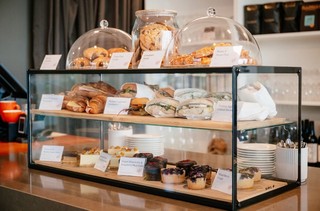
Eat & drink / View full image
Information for families
Cloak rooms
Cloak rooms are at the entries to both QAG and GOMA. You can keep bags containing care needs for your family, baby carriers being used to carry a child, or baby bags securely attached to a pram or carried.
Parents’ rooms
There are two parents’ rooms at QAG, one near the Stanley Place entrance and one near the Pelican Lounge, both on the Watermall level, there is also a parents’ room at GOMA, in the Cinema Foyer.
Prams
Prams are welcome, and all areas of QAG and GOMA are accessible by lift or ramp. Pram parking is available near the entrance to the Children's Art Centre at GOMA.
Two neighbouring galleries
Our two galleries, only 150 metres apart, are a short walk from the city centre and adjacent to South Bank Parklands. QAG's riverfront entry is near Melbourne St and Victoria Bridge, and both buildings have an entrance from Stanley Place.
Parking for the Cultural Precinct is available in two carparks under QAG and State Library of Queensland, both accessible via Stanley Place.
QAGOMA is right next to the Cultural Centre Busway station and a short walk from the South Brisbane train station and the South Bank CityCat and Ferry terminal.
Visit QAGOMA daily: Open 10.00 am – 5.00 pm
Open from 12 noon Anzac Day. Closed Good Friday, Christmas Day & Boxing Day
We look forward to welcoming you. Enjoy your visit!
Queensland Art Gallery

Queensland Art Gallery, Melbourne Street entrance / View full image
Gallery of Modern Art

Gallery of Modern Art, Stanley Place entrance / View full image
Elliott Murray is Senior Digital Marketing Officer, QAGOMA

